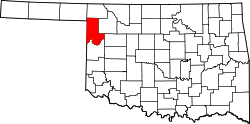History
The town was a part of the now non-existent Day County during its period of being referred to as E County. [3] [5] It was the county seat of said place for a short period of time until it was switched to Grand on November 13, 1893. [6]
As of 1893, Ioland had a store, hotel, courthouse, and several places of residence. Alongside this, Ioland also had a triweekly mail route via the neighboring community of Grand's post office; the route would go to Higgins, Texas. They also had a weekly mail route to Camargo, Oklahoma. [1]
The first man lynched in Oklahoma since its organization as a territory, J.L. Chandler, was a resident of Ioland. He was lynched by a group of cattlemen due to allegedly poisoning their cattle's water supply. [7]
Ioland had its own school, aptly named Ioland School, located inside a log cabin built in 1894. [5] The school was a half mile above the aforementioned Ioland Cemetery. [2] As of 1974, the Ioland School was switched from a schooling facility to a community center and voting place. [8]
County seat switch
The county seat location was switched from Ioland to Grand due to multiple reasons, the first reason being that the town had what was considered to be “bad tasting water,” with there being no other good available sources for water near the town either. [3] [4]
Secondly, the location of Ioland was known for being inconvenient for most residents, due to most of the population of Day County living at the other side of the Canadian River. [3]
Thirdly, and finally, Day County's county courthouse, located in Ioland, was burnt down on November 12, 1893. This prompted the switch of the county seat to Grand the day after. [a]
Newspaper
Around October 1, 1893, father F.M. Smith, and his son Harry, came to Day County. The duo formed a newspaper, titled the “Day County Tribune”, which was printed with a Washington brand printing press. The tribune was scheduled to be published every Thursday, but would sometimes be late. F.M. was the editor, publisher, and founder of the newspaper, whereas Harry was the assistant and associate editor. Their newspaper was originally headquartered in Ioland, and they would often write stories about the town. [1]
The first subscriber of the Day County Tribune was probate judge, Robert Alcorn. Through the course of the newspapers life, it went through several owners, editors, and publishers, all of whom were relatives of the aforementioned Robert Alcorn, with only one outlier being a lady by the name of Lizzie Mead. The newspaper had a subscription rate of one dollar a year. The newspaper, alongside the county courthouse, was moved to Grand on the November 13, 1893, thus ceasing operations in Ioland. [1]
This page is based on this
Wikipedia article Text is available under the
CC BY-SA 4.0 license; additional terms may apply.
Images, videos and audio are available under their respective licenses.



